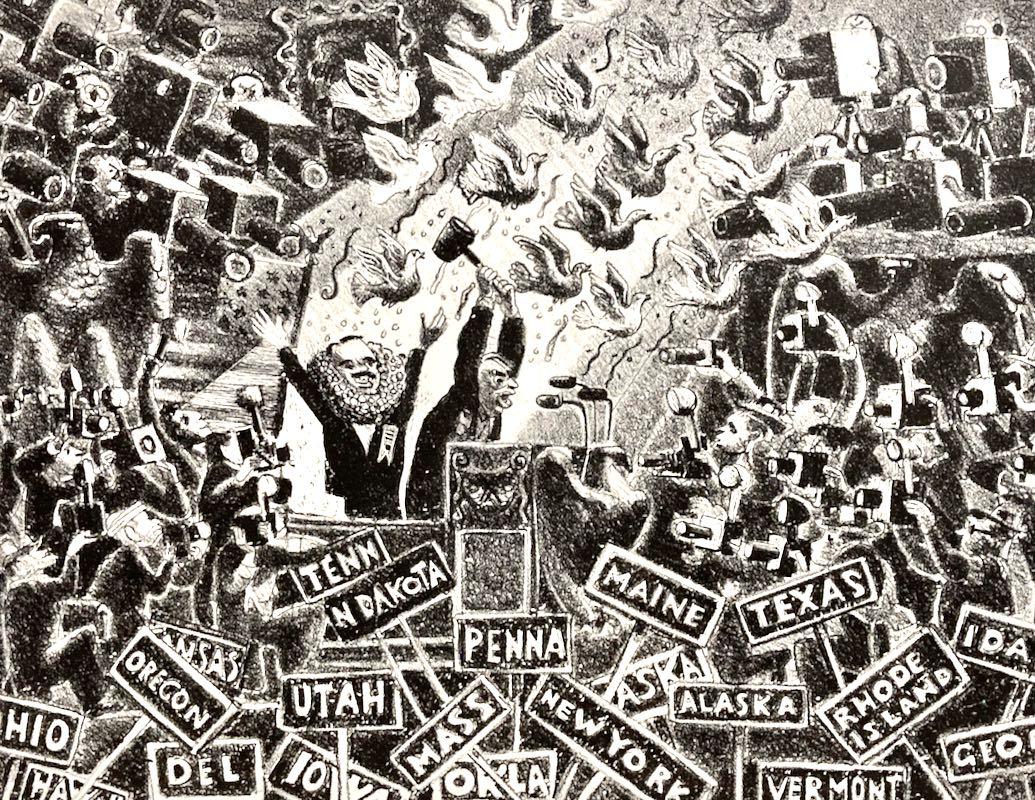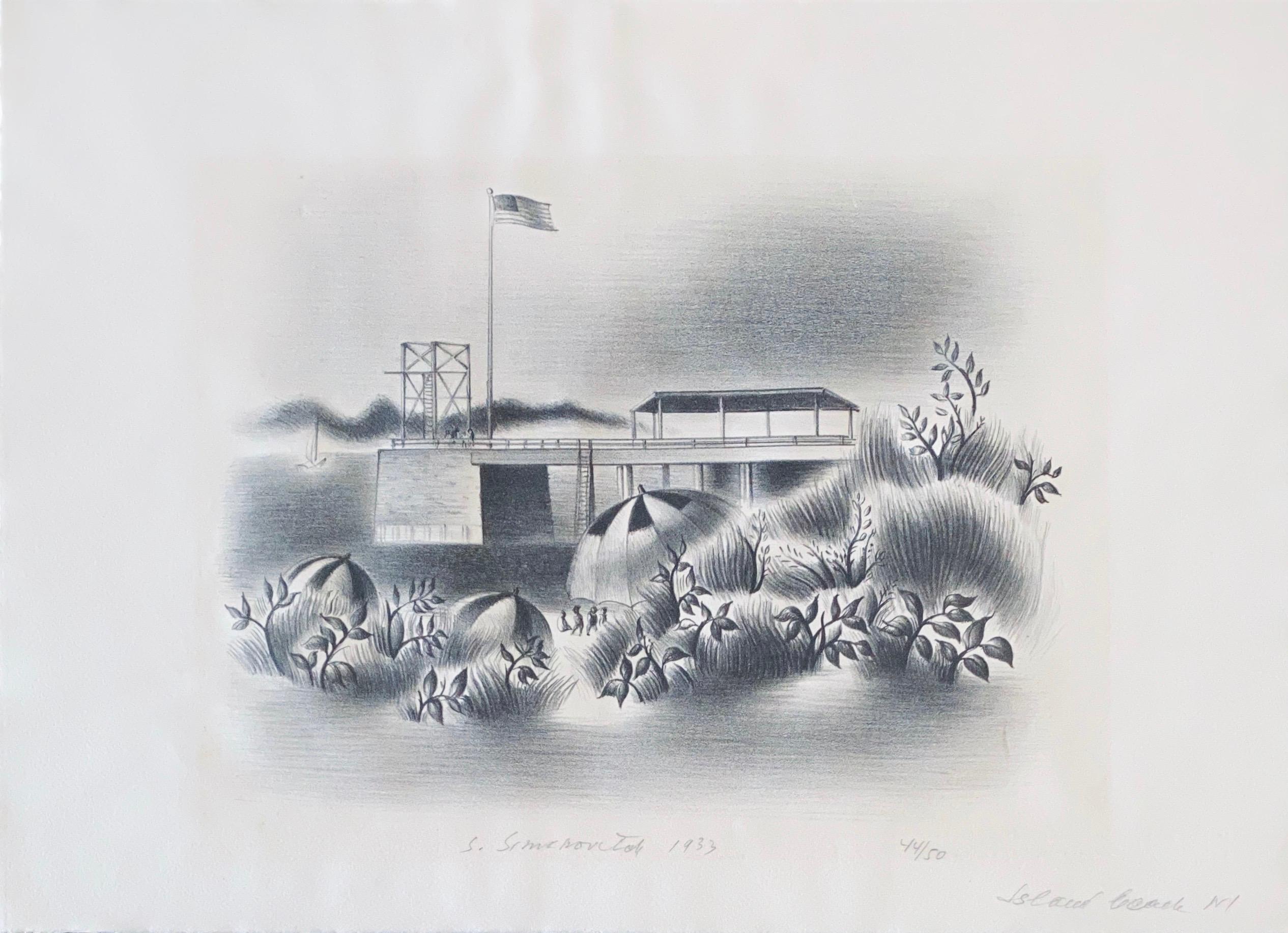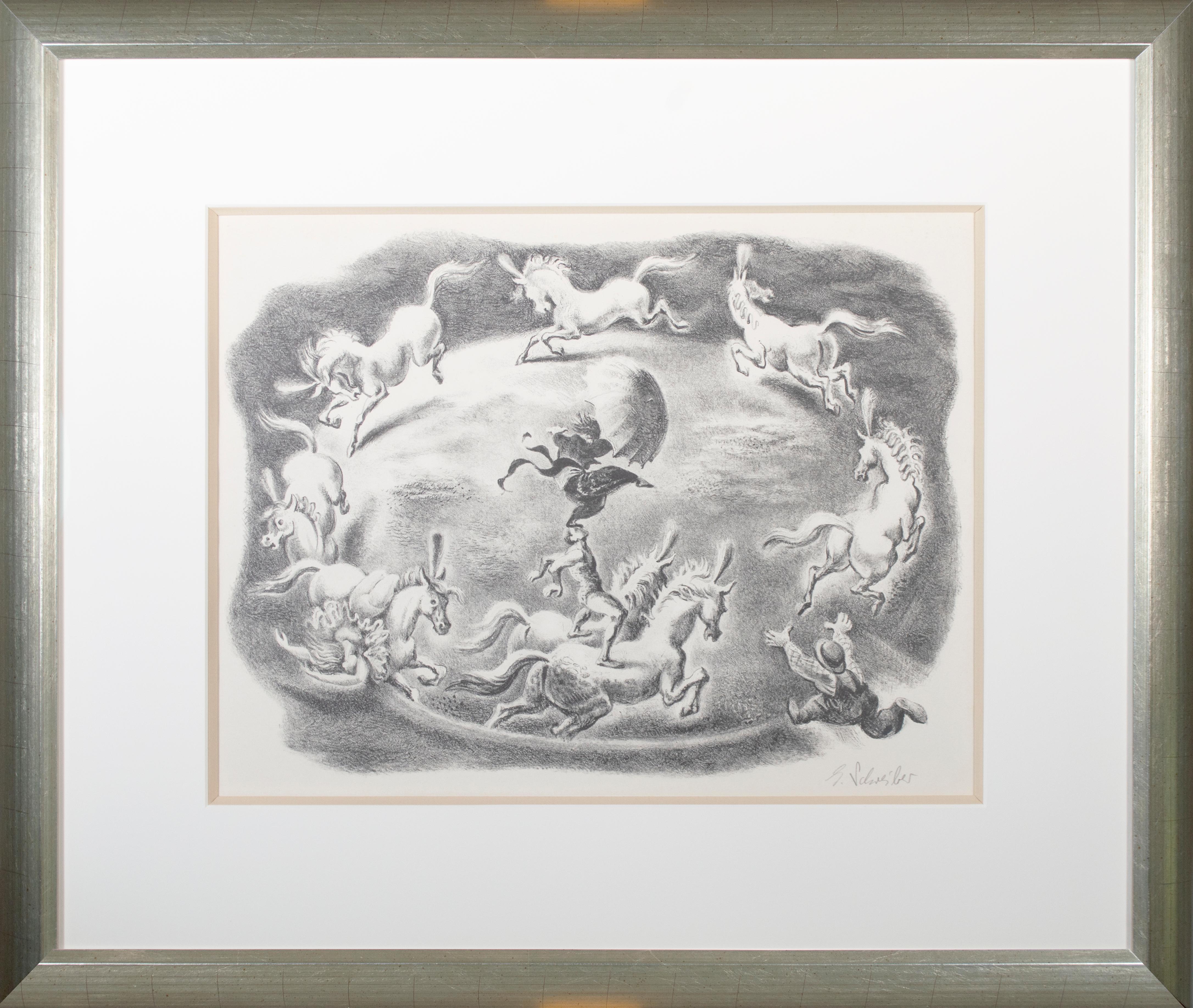Items Similar to 'Tanks #1' — 1920s American Precisionism
Want more images or videos?
Request additional images or videos from the seller
1 of 3
Louis Lozowick'Tanks #1' — 1920s American Precisionism1929
1929
About the Item
Louis Lozowick, 'Tanks #1', lithograph, 1929, edition 50, Flint 39. Signed, titled, and numbered '11/50' in pencil. Signed with the artist's monogram in the stone, lower left. A superb, richly-inked impression, on cream wove paper, the full sheet with margins (3/4 to 1 7/8 inches), in excellent condition. Matted to museum standards.
Image size 13 15/16 x 8 1/16 inches (355 x 204 mm), sheet size 15 3/4 x 11 1/4 inches (400 x 286 mm).
Exhibited: 'The American Scene: Prints from Hopper to Pollock', Stephen Coppel, The British Museum, 2008.
Literature: 'Prints and Their Creators, A World History', Carl Zigrosser, Crown Publishers Inc, 1974; 'American Lithographers 1900-1960: The Artists and Their Printers', Clinton Adams, The University of New Mexico Press, 1983; 'The American Scene: Prints from Hopper to Pollock', Stephen Coppel, The British Museum, 2008.
Impressions of this work are in the following museum collections: Amon Carter Museum of American Art, Birmingham Museum of Art, The British Museum, Brooklyn Museum, New York Public Library, Pennsylvania Academy of the Fine Arts, Philadelphia Museum of Art, Smithsonian American Art Museum.
ABOUT THE ARTIST
“A beautifully articulated synthesis of strong personal visions and an extraordinary command of black-and-white lithography remained constant. His prints have withstood the inevitable fluctuations of fashion and taste, and today are deservedly appreciated by both connoisseurs and a new generation as among the finest created in twentieth-century America.”
—Janet Flint, The Prints of Louis Lozowick: A Catalogue Raisonné, Hudson Hills Press, NY, 1982.
Born in Russia in 1892, Lozowick came to this country at the age of 14 to join his brother in New York City. By 1919, he had attended art school, finished college, served in the army, and traveled throughout the United States, visiting major cities that would later become subjects of his work. From 1919 to 1924, Lozowick lived and traveled throughout Europe, staying in Paris, Berlin, and Moscow. While in Berlin, he became friends with Laszlo Moholy-Nagy, El Lissitsky, and the avant-garde Russian artists affiliated with the Novembergruppe. On his return to New York in 1924, he joined the executive board of the New Masses and exhibited his machine age drawings, the ‘Machine Ornament’ series in the 1926 exhibition of Katherine Dreier’s Société Anonyme; three years later, he made his first prints.
Having assimilated European Constructivist and Cubist theories and the Bauhaus manifesto promoting the integration of applied and fine art, Lozowick was inspired to present the rapidly growing New York City skyline with its monumental skyscrapers as modern symbols of optimism. Like many other Depression-era artists, he identified closely with the common worker and valued the consummate craft and workmanship dictated by the printmaking process. His versatility and range of interests were exemplified by his stage sets for the 1926 production of Georg Kaiser’s play “Gas,” the first Constructivist production seen in America. A year later, his images and essay were centerpieces in the pivotal 1927 Machine Age Exposition in New York. Lozowick’s first solo exhibition of lithographs depicting primarily soaring urban cityscapes and industrial scenes was mounted by the renowned Weyhe Gallery in 1929.
Assigned to the WPA New York Graphic Arts Division in 1935, he left in 1936 to accept a commission from the prestigious Treasury Relief Art Project for two large oil paintings for the Post Office at 33rd Street in Manhattan. His preliminary lithographic studies for the paintings are among his most compelling images of New York skyscraper and bridge forms.
Returning to the Project in 1938, Lozowick experimented with various printmaking mediums, including wood engraving, drypoint, and screen printing, until the end of his appointment in 1940. During the next three decades, encouraged by Carl Zigrosser of the Weyhe Gallery, he devoted himself primarily to lithography, mounting several solo exhibitions at major New York galleries and a retrospective at the Whitney Museum of American Art in 1972. Posthumous solo and group exhibitions of Lozowick’s work include the Hirshhorn Museum and Sculpture Garden (2001), de Young Museum (2007), British Museum (2008), National Gallery of Art, Washington D.C. (2015), Whitney Museum of American Art (2015), Brooklyn Museum of Art (2015), and the Palmer Museum of Art (2019).
Louis Lozowick’s graphic works are held in numerous prominent museum collections, including the Amon Carter Museum of American Art, Art Institute of Chicago, Baltimore Museum of Art, Brooklyn Museum, Cornell University Library, Museum of Fine Arts (Boston), Museum of Modern Art, New York Public Library, Philadelphia Museum of Art, Smithsonian American Art Museum, Walker Art Center, and the Whitney Museum of American Art.
- Creator:Louis Lozowick (1892 - 1973, American)
- Creation Year:1929
- Dimensions:Height: 13.94 in (35.41 cm)Width: 8.07 in (20.5 cm)
- Medium:
- Movement & Style:
- Period:
- Condition:
- Gallery Location:Myrtle Beach, SC
- Reference Number:
Louis Lozowick
Louis Lozowick is widely recognized as a key figure in America's Precisionist movement and a leader in mid-20th-century modernist printmaking. His graphic works and paintings have been acquired by numerous museums including the Art Institute of Chicago, Brooklyn Museum, Crystal Bridges Museum of American Art, Fine Arts Museums of San Francisco, Metropolitan Museum of Art, Museum of Modern Art, New York Public Library, Philadelphia Museum of Art, Smithsonian American Art Museum, U. S. Library of Congress and the Whitney Museum of American Art.
About the Seller
5.0
Recognized Seller
These prestigious sellers are industry leaders and represent the highest echelon for item quality and design.
Platinum Seller
These expertly vetted sellers are 1stDibs' most experienced sellers and are rated highest by our customers.
Established in 1995
1stDibs seller since 2016
259 sales on 1stDibs
Typical response time: 1 hour
Associations
International Fine Print Dealers Association
- ShippingRetrieving quote...Ships From: Myrtle Beach, SC
- Return PolicyA return for this item may be initiated within 7 days of delivery.
More From This SellerView All
- Winter Fun — Mid-century Modernism, Central Park, New York CityBy Louis LozowickLocated in Myrtle Beach, SCLouis Lozowick, 'Winter Fun', lithograph, 1940, edition 20, 250 (1941). Flint 188. Signed in pencil, with the artist’s monogram in the stone, lower left. A...Category
1940s American Modern Figurative Prints
MaterialsLithograph
- 'Financial District', New York City — 1930s American ModernismBy Howard Norton CookLocated in Myrtle Beach, SCHoward Cook, 'Financial District', lithograph, 1931, edition 75, Duffy 155. A fine, richly-inked impression, on cream wove paper, the full sheet with wide margins (2 3/4 to 5 5/8 inches), in excellent condition. Image size 13 5/16 x 10 3/8 inches (338 x 264 mm); sheet size 23 x 16 inches (584 x 406 mm). Matted to museum standards, unframed. Literature: 'American Master Prints from the Betty and Douglas Duffy Collection', the Trust for Museum Exhibitions, Washington, D.C., 1987. Collections: Crystal Bridges Museum of American Art, Library of Congress, Metropolitan Museum of Art, Philadelphia Museum of Art, Smithsonian American Art Museum. ABOUT THE ARTIST Howard Norton Cook (1901-1980) was one of the best-known of the second generation of artists who moved to Taos. A native of Massachusetts, he studied at the Art Students League in New York City and at the Woodstock Art Colony. Beginning his association with Taos in 1926, he became a resident of the community in the 1930s. During his career, he received two Guggenheim Fellowships and was elected an Academician in the National Academy of Design. He earned a national reputation as a painter, muralist, and printmaker. Cook’s work in the print mediums received acclaim early in his career with one-person exhibitions at the Denver Art Museum (1927) and the Museum of New Mexico (1928). He received numerous honors and awards over the years, including selection in best-of-the-year exhibitions sponsored by the American Institute of Graphics Arts, the Brooklyn Museum, the Society of American Etchers, and the Philadelphia Print Club. His first Guggenheim Fellowship took him to Taxco, Mexico in 1932 and 1933; his second in the following year enabled him to travel through the American South and Southwest. Cook painted murals for the Public Works of Art Project in 1933 and the Treasury Departments Art Program in 1935. The latter project, completed in Pittsburgh, received a Gold Medal from the Architectural League of New York. One of his most acclaimed commissions was a mural in the San Antonio Post Office in 1937. He and Barbara Latham settled in Talpa, south of Taos, in 1938 and remained there for over three decades. Cook volunteered in World War II as an Artist War Correspondent for the US Navy, where he was deployed in the Pacific. In 1943 he was appointed Leader of a War Art Unit...Category
1930s American Modern Figurative Prints
MaterialsLithograph
- 'de Young Mansion – San Francisco' — 1930s California WPALocated in Myrtle Beach, SCMarguerite Redman Dorgeloh, 'de Young Mansion – San Francisco', lithograph, c. 1937, edition 25. Signed and titled in pencil. A fine, richly-inked impr...Category
1930s American Modern Figurative Prints
MaterialsLithograph
- 'I'll Be What I Choose' — Mid-century American SurrealismBy Benton Murdoch SpruanceLocated in Myrtle Beach, SC'I'll Be What I Choose: Vanity of Ambition', color lithograph, 1949, edition 40, Fine and Looney 281. Signed, titled, and numbered '23/40' in pencil. Initialed in the stone, lower ri...Category
1940s American Modern Figurative Prints
MaterialsLithograph
- 'Fruit Piece' — 1920's American ModernismLocated in Myrtle Beach, SCPamela Bianco, 'Fruit Piece', lithograph, c. 1925. Signed and titled in pencil. Signed in the stone, lower left. Annotated 'No. 8' in pencil, upper right...Category
1920s American Modern Figurative Prints
MaterialsLithograph
- 'Eyes for the Night' — Mid-century ModernismBy Benton Murdoch SpruanceLocated in Myrtle Beach, SCBenton Spruance, 'Eyes for the Night', lithograph, 1947, edition 35, Fine and Looney 260. Signed, dated, titled, and annotated 'Ed 35' in pencil. A fine impression, on heavy, cream ...Category
1940s American Modern Figurative Prints
MaterialsLithograph
You May Also Like
- Seated NudeBy Richard DiebenkornLocated in Laguna Beach, CAA highly influential mid-century American artist, Richard Diebenkorn is known for his abstract landscape paintings, in particular, the "Ocean Park" series, which he exhibited when re...Category
1960s American Modern Figurative Prints
MaterialsLithograph
- Alfred Bendiner, ...And So..., 1948, Republican Convention nominating DeweyBy Alfred BendinerLocated in New York, NYThe full title really should be ...And So I Give Your The Next President of the United States. The scene is the Republican Convention, in Philadelphia, in 1948. There are so many fas...Category
Mid-20th Century American Modern Portrait Prints
MaterialsLithograph
- Simka Simkhovitch WPA Artist Lithograph Island Beach 1933 American ModernistBy Simka SimkhovitchLocated in Surfside, FLSimka Simkhovitch (Russian/American 1893 - 1949) signed lithograph. Pencil signed and dated "S. Simkhovitch 1933" lower center. Title "Island Beach," in pencil lower left of sheet. Numbered "44/50" in pencil lower right. (it is either Island Beach Wisconsin or New Jersey) Simka Simkhovitch (Симха Файбусович Симхович) (aka Simka Faibusovich Simkhovich) (Novozybkov, Russia May 21, 1885 O.S./June 2, 1885 N.S.—Greenwich, Connecticut February 25, 1949) was a Ukrainian-Russian Jewish artist and immigrant to the United States. He painted theater scenery in his early career and then had several showings in galleries in New York City. Winning Works Progress Administration (WPA) commissions in the 1930s, he completed murals for the post offices in Jackson, Mississippi and Beaufort, North Carolina. His works are in the permanent collections of the Dallas Museum of Art, the National Museum of American Art and the Whitney Museum of American Art. Born outside Kyiv (Petrograd Ukraine) into a Jewish family who owned a small department store. During a severe case of measles when he was seven, Simcha Simchovitch sketched the views outside his window and decided to become an artist, over his father's objections. Beginning in 1905, he studied at the Grekov Odessa Art School and upon completion of his studies in 1911 received a recommendation to be admitted to the Imperial Academy of Arts. Though he enrolled to begin classes in architecture, painting, and sculpture at the Imperial Academy, he was dropped from the school roster in December because of the quota on the number of Jewish students and drafted into the army. Simchovitch served as a private in the 175th Infantry Regiment Baturyn [ru] until his demobilization in 1912. Re-enrolling in the Imperial Academy, he audited classes. Simka Simkhovitch exhibited paintings and sculptures in 1918 as part of an exhibition of Jewish artists and in 1919 placed 1st in the competition "The Great Russian Revolution" with a painting called "Russian Revolution" which was hung in the State Museum of Revolution. In 1922, Simkha Simkhovitch exhibited at the International Book Fair in Florence (Italian: Fiera Internazionale del Libro di Firenze). In 1924, Simkhovitch came to the United States to make illustrations for Soviet textbooks and decided to immigrate instead. Initially he supported himself by doing commercial art and a few portrait commissions. In 1927, he was hired to paint a screen for a scene in the play "The Command to Love" by Fritz Gottwald and Rudolph Lothar which was playing at the Longacre Theatre on Broadway. Art dealers began clamoring for the screen and Simkhovitch began a career as a screen painter for the theater. Catching the attention of the screenwriter, Ernest Pascal, he worked as an illustrator for Pascal, who then introduced him to gallery owner, Marie Sterner. Simkhovitch's works appeared at the Marie Sterner Gallery beginning with a 1927 exhibit and were repeated the following year. Simkhovitch had an exhibit in 1929 at Sterner's on circus paintings. In 1931, he held a showing of works at the Helen Hackett Gallery, in New York City and later that same year he was one of the featured artists of a special exhibit in San Francisco at the California Palace of the Legion of Honor in Lincoln Park. The exhibit was coordinated by Marie Sterner and included four watercolors, including one titled "Nudes". He is of the generation of Russian Soviet artists such as Isaac Pailes, Serge Charchoune, Marc Chagall, Chana Orloff, Isaac Ilyich Levitan, and Ossip Zadkine. In 1936, Simkhovitch was selected to complete the mural for the WPA Post office project in Jackson, Mississippi. The mural was hung in the post office and courthouse in 1938 depicted a plantation theme. Painted on the wall behind the judge’s bench, “Pursuits of Life in Mississippi”, a depiction of black workers engaged in manual labor amid scenes of white professionals and socialites, was eventually covered over in later years during renovations due to its stereotypical African American imagery. The following year, his painting "Holiday" won praise at an exhibition in Lincoln, Nebraska. In 1940, Simkhovitch's second WPA post office project was completed when four murals, "The Cape Lookout Lighthouse and the Orville W. Mail Boat", "The Wreck of the Crissie Wright", "Sand Ponies" and "Canada Geese" were installed in Beaufort, North Carolina. The works were commissioned in 1938 and did not generate the controversy that the Jackson mural had. The main mural is "The Wreck of the Crissie Wright" and depicts a shipwreck which had occurred in Beaufort in 1866. "The Cape Lookout Lighthouse and the Orville W. Mail Boat" depicted the lighthouse built in 1859 and the mail boat that was running mail during the time which Simkhovitch was there. The boat ran mail for the area until 1957. "Sand Ponies" shows the wild horses common to the North Carolina barrier islands and "Canada Geese" showed the importance of hunting and fishing in the area. All four murals were restored in the 1990s by Elisabeth Speight, daughter of two other WPA muralists, Francis Speight...Category
1930s American Modern Landscape Prints
MaterialsLithograph
- Alfred Bendiner, On VacationBy Alfred BendinerLocated in New York, NYNo matter the seriousness (or lack thereof) of the subject, everything is always beautifully drawn on the lithographic stone by Bendiner. In this 'Day at the Beach' scene Bendiner h...Category
1940s American Modern Animal Prints
MaterialsLithograph
- 'Circular Motion' original lithograph signed by Georges SchreiberBy Georges SchreiberLocated in Milwaukee, WIIn this lithograph, Georges Schreiber focused on the thrill of the circus, taking its circular composition from the central ring. Here, acrobats perform amazing feats of agility on t...Category
1940s American Modern Animal Prints
MaterialsLithograph
- Alfred Bendiner, Flic et Bonne (Gendarme and Nursemaid)By Alfred BendinerLocated in New York, NYThe world was Bendiner's oyster, but here he shows us a all we need in a small corner of Paris. It's charming and safe: the 'Flic et Bonne' (gendarme and nursemaid) are together, goi...Category
1950s American Modern Landscape Prints
MaterialsLithograph
Recently Viewed
View AllMore Ways To Browse
New York City 1920s
American Industrial Age
Black And Cream Modern Art
Antique Post Office
Post Office Antique
Antique American Standard
Antique Print British Set
1920s Crown
Paris Street Scene Lithograph
Antique Printing Press
Printing Press Antique
Urban Garden Print
Black And White Set Of 4 Paintings
Antique Ink Stone
Antique Industrial Machines
Set Of 4 Pencil Drawings
Wpa Pencil Drawing
Tank Wood





